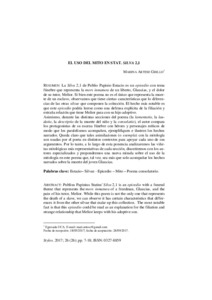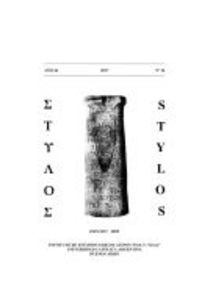Please use this identifier to cite or link to this item:
https://repositorio.uca.edu.ar/handle/123456789/9768| Título: | El uso del mito en stat. Silva 2,1 | Autor: | Artese Grillo, Marina | Palabras clave: | Estacio, Publio Papinio; LITERATURA ROMANA; MITO; EPICEDIO; POEMA; MUERTE | Fecha de publicación: | 2017 | Editorial: | Universidad Católica Argentina. Facultad de Filosofía y Letras. Instituto de estudios grecolatinos "Prof. F. Nóvoa" | Cita: | Artese Grillo, M. El uso del mito en stat. Silva 2,1 [en línea]. Stylos. 2017, 26. Disponible en: https://repositorio.uca.edu.ar/handle/123456789/9768 | Resumen: | Resumen: La Silva 2,1 de Publio Papinio Estacio es un epicedio con tema fúnebre que representa la mors inmatura de un liberto, Glaucias, y el dolor de su tutor, Melior. Si bien este poema no es el único que representa la muer-te de un esclavo, observamos que tiene ciertas características que lo diferen-cias de las otras silvae que componen la colección. El hecho más notable es que este epicedio podría leerse como una defensa explícita de la filiación y extraña relación que tiene Melior para con su hijo adoptivo.
Asimismo, durante las distintas secciones del poema (la lamentatio, la lau-datio, la descriptio de la muerte del niño y la consolatio), el autor compara los protagonistas de su escena fúnebre con héroes y personajes míticos de modo que los paralelismos acompañen, ejemplifiquen e ilustren los hechos narrados. Queda claro que tales asimilaciones (o exempla) con la mitología son usadas por el poeta en distintos contextos para apoyar cada uno de sus argumentos. Por lo tanto, a lo largo de esta ponencia analizaremos las viñe-tas mitológicas más representativas de cada sección, discutiremos con los au-tores especializados y propondremos una nueva mirada sobre el uso de la mitología en este poema que, tal vez, sea más que solo acompañar los hechos narrados sobre la muerte del joven Glaucias. Abstract: Publius Papinius Statius' Silva 2,1 is an epicedio with a funeral theme that represents the mors inmatura of a freedman, Glaucias, and the pain of his tutor, Melior. While this poem is not the only one that represents the death of a slave, we can observe it has certain characteristics that differ-ences it from the other silvae that make up this collection. The most notable fact is that this epicedio could be read as an explanation for the filiation and strange relationship that Melior keeps with his adoptive son. Likewise, through different sections of the poem (the lamentatio, the laudatio, the descriptio of the child's death, and the consolatio) the au-thor compares the main characters of the scene with heroes and mythical characters so that parallelisms join, exemplify and illustrate the narrated facts. It is clear that such assimilations (or exempla) with mythology are used by the poet through different contexts to support each one of his arguments. Thus, throughout this lecture we will analyze the mythological vignettes that best represent each section, we will discuss with the specialized authors and we will propose a new look about the use of mythology in this poem that may appear to be more than just to join the narrated facts about the death of young Glaucias. |
URI: | https://repositorio.uca.edu.ar/handle/123456789/9768 | ISSN: | 0327-8859 | Disciplina: | LITERATURA | Derechos: | Acceso abierto | Fuente: | Stylos Nº 26, 2017 |
| Appears in Collections: | STY - 2017 nro. 26 |
Files in This Item:
| File | Description | Size | Format | |
|---|---|---|---|---|
| uso-mito-stat-silva.pdf | 189,56 kB | Adobe PDF |  View/Open | |
| stylos26.jpg | 106,33 kB | JPEG |  View/Open |
Page view(s)
282
checked on Nov 28, 2025
Download(s)
192
checked on Nov 28, 2025
Google ScholarTM
Check
This item is licensed under a Creative Commons License

